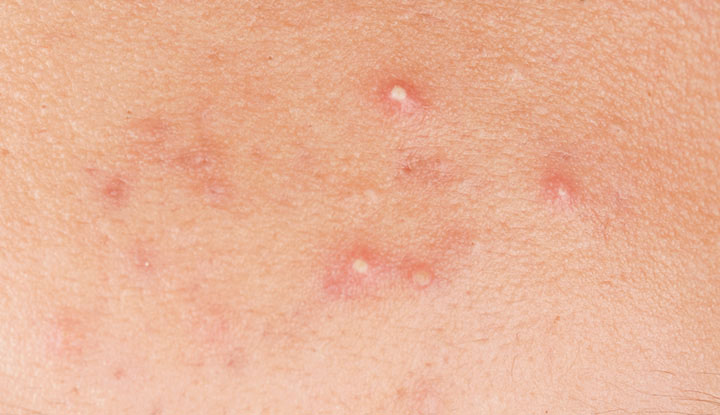Whiteheads are a very common skin condition that mostly affects your face, neck, back and chest. There are a variety of causes, including too much oil on your skin and hair follicle irritation. Whiteheads commonly affect adolescents, but they can occur at any age.
Advertisement
Cleveland Clinic is a non-profit academic medical center. Advertising on our site helps support our mission. We do not endorse non-Cleveland Clinic products or services. Policy

Whiteheads are a type of acne (acne vulgaris). Oil and dead skin close off hair follicles or sebaceous glands (oil glands) and form a closed bump on your skin (comedo, plural comedones).
Advertisement
Cleveland Clinic is a non-profit academic medical center. Advertising on our site helps support our mission. We do not endorse non-Cleveland Clinic products or services. Policy
Whiteheads look like small bumps sticking up on your skin. They are white or yellowish in appearance.
Blackheads and whiteheads are comedones. Blackheads are open bumps on the skin. They look as if dirt is in the bump, but an irregular light reflection off the clogged follicle actually causes the dark spots. Whiteheads are closed bumps on the skin. They look white or yellowish.
Whiteheads typically affect teenagers and young adults undergoing hormonal changes. However, many adults continue to have whiteheads into their 20s, 30s and beyond. Some even develop whiteheads for the first time as adults.
Whiteheads are very common. Some researchers suggest that whiteheads affect nearly everyone at some time during their lives. They’re most common among adolescence, but 10% to 20% of adults have whiteheads too.
Your face (especially your nose, chin and forehead, sometimes your cheeks or around your mouth), neck, back, chest and upper arms are most likely to develop whiteheads. However, oil glands are all over your body. They release an oily lubricant called sebum that helps keep your skin and hair hydrated and shiny. As a result, though it isn’t common, whiteheads sometimes appear on your butt, thighs, ears, scalp, armpits and genitals (penis and vulva).
Advertisement
Whiteheads don’t seriously affect your physical health, but they can affect you psychosocially (how society and social groups affect your mind) and psychologically (your self-perception and behavior). They are sometimes associated with anxiety, depression, mood disorders and suicidal thoughts.
Whiteheads are a milder form of acne. White or yellowish bumps are the main characteristic of whiteheads. They may be slightly tender or you may have no symptoms at all.
Sebaceous glands are located all over your body, and most of them connect to hair follicles. Whiteheads occur when a hair follicle/sebaceous gland becomes inflamed. Inflammation can occur as a result of:
Whiteheads aren’t contagious. You can’t spread them to another person through skin-to-skin contact.
Whiteheads are easy to recognize, so you don’t necessarily need a healthcare professional to diagnose them. Air causes blackheads to look dark. Air doesn’t reach whiteheads, so they look white or yellowish. If you have whiteheads along with other severe forms of acne, see a dermatologist for treatment. Dermatologists are doctors who specialize in conditions that affect your skin, hair and nails.
Nonprescription medications can get rid of whiteheads on your face. Some medications include:
If your whiteheads don’t go away with nonprescription medications, your healthcare provider or a medical aesthetician may recommend:
Advertisement
Popping whiteheads can be very tempting — and satisfying. However, it would be best if you didn’t squeeze your whiteheads. Squeezing whiteheads can cause several problems:
Advertisement
Most whiteheads go away on their own, but it may take a little time—sometimes up to seven days. It’s better to see a healthcare provider at the first sign of whiteheads and follow their treatment suggestions.
If you have whiteheads, be careful managing them so they don’t get irritated. You can do this by:
Whiteheads often go away in early adulthood, though some people will continue to experience them throughout their lives. Your healthcare provider, medical aesthetician or dermatologist can help you manage your whiteheads.
Preventing whiteheads is difficult, if not impossible, during normal hormonal changes. But some things can help:
See your healthcare provider as soon as you notice whiteheads to start treatment immediately.
Advertisement
Whiteheads are a common skin condition that affects the majority of people, especially adolescents. Because it mainly affects adolescents, many people attribute whiteheads as part of the transition from childhood to adulthood and don’t see a healthcare provider about them. However, despite how common they are, they can have a severe effect on your mental health. If you notice symptoms of anxiety or depression due to the presence of whiteheads, talk to your healthcare provider.
Cleveland Clinic’s primary care providers offer lifelong medical care. From sinus infections and high blood pressure to preventive screening, we’re here for you.

Last reviewed on 11/12/2021.
Learn more about the Health Library and our editorial process.